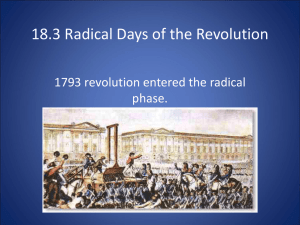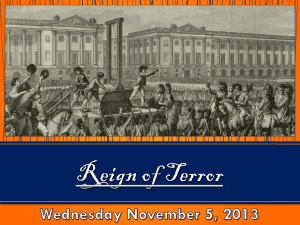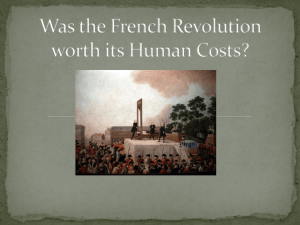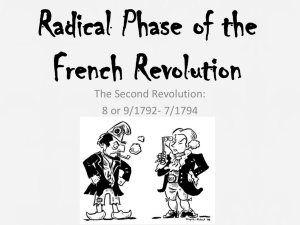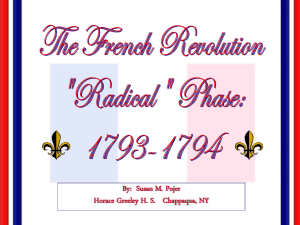6-3 Powerpoint - McCook Public Schools
advertisement
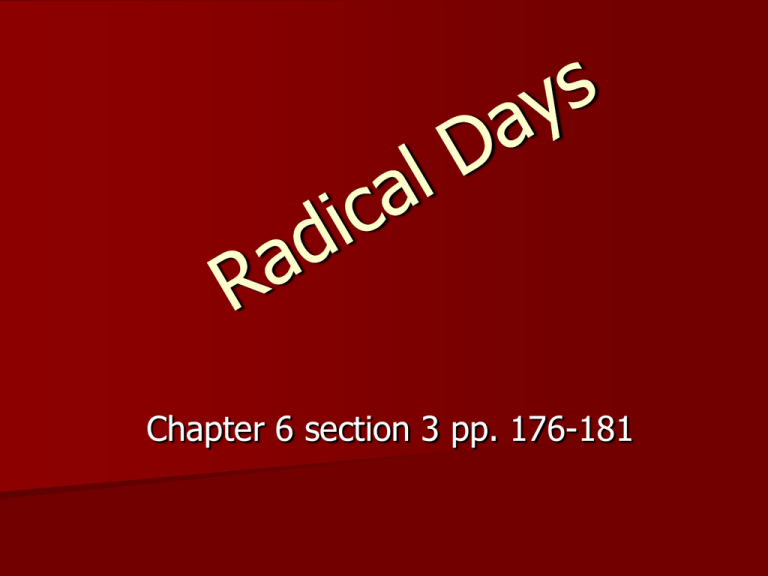
Chapter 6 section 3 pp. 176-181 Setting the Scene Someone who had left Paris in 1791 and returned in 1793 could have gotten lost. Almost 4,000 streets had new names. Louis XV Square was renamed the Square of the Revolution. King of Sicily street, named for the brother of Louis XVI, had become the Rights of Man Street. Renaming streets was one way that Jacobins tried to wipe out all traces of the old order. In 1793, the revolution entered a radical phase. For a year France experienced one of the bloodiest regimes in its long history as determined leaders sought to extend and preserve the revolution. The Monarchy Abolished Dismal news about the war heightened tensions. Well trained Prussian forces were cutting down raw French recruits. Royalist officers deserted the French army, joining emigres and others hoping to restore the king’s power. Outbreaks of Violence On August 10th, 1792, a crowd of Parisians stormed the Tuileries and slaughtered the king’s royal guards. The royal family fled to the legislative assembly. Citizens attacked prisons and killed Nobles and Priests accused of political offenses, along with “normal criminals”. The attacks became known as the “September Massacres.” Historians have different views on the people that carried out the attacks, some call them “bloodthirsty” others call them revolutionaries. The French Republic Radicals called for the election of a new legislative body called the National Convention. Suffrage the right to vote, was to be extended to all male citizens, not just property owners. On September 1792, a convention met that wanted to abolish the monarchy and declare France a republic. The Jacobins, who controlled the Convention, set out to erase all traces of the old order. They seized lands of nobles and abolished titles of nobility. This new legislative body was more radical than anyone expected. Death of the King and Queen During the early months of the Republic, the Convention also put Louis XVI on trial as a traitor of France. He was later put to death in January 1793 in a public square in Paris. Death of the Queen Marie Antoninette was executed in October of 1793. She showed great dignity as she went to her death. The press celebrated her death. Crown Prince Louis XVII died of unknown causes in the dungeons in 1795???? At age 10. The Convention Defends the Republic In 1793, danger threatened France on all sides. The country was at war with most of Europe, including Britain, the Netherlands, Spain, and Prussia. Priests led peasants in rebellion against the government in France. In Paris the Sans-Culottes demanded relief from food shortages. The Convention was bitterly divided between Jacobins and a rival group, the Girondins. Committee of Public Safety The Convention created the Committee of Public Safety. The 12-member committee had almost absolute power as it battled to save the revolution. The committee prepared France for a war, issuing a levée en masse, or mass levy that required all citizens to contribute to the war effort. Soon, French armies overran the Netherlands. They invaded Italy. European monarchs shuddered as the revolutionaries carried “freedom fever” into conquered lands. Robespierre, a shrewd lawyer and politician, rose to leadership of the Committee of Public Safety. Among Jacobins, his selfless dedication to the revolution earned him the nickname “The Incorruptible.” The enemies of Robespierre called him a tyrant. Robespierre had embraced Rousseau’s idea of the general will as the source of all legitimate law. He promoted religious toleration and wanted to abolish slavery. He was popular with the SansCulottes, who hated the old regime as much as he did. He believed that France could achieve a “republic of virtue” only through the use of terror. “Liberty cannot be secured, unless criminals lose their heads!” Robespierre The Reign of Terror Robespierre was one of the chief architects of the Reign of Terror, which lasted from about July 1793 to July 1794. Revolutionary courts conducted hasty trials. Spectators greeted death sentences with cries of “Hail the Republic!” or “Death to traitors!” Perhaps 40,000 people died during the terror. Most were peasants involved in riots or revolts and were executed. The engine of the Terror was the guillotine. Its fast falling blade extinguished life instantly. A member of the legislature, Dr. Joseph Guillotin had introduced it as a more humane method of beheading that an uncertain axe, but it quickly became a symbol of horror. Reign of Terror cont. Weary of bloodshed and fearing for their own lives, members of the Convention turned on the Committee of Public Safety. On the night of July 27, 1794, Robespierre was arrested. The next day he was executed. After the heads of Robespierre and other radicals fell, fewer executions took place. Reaction and the Directory The Constitution of 1795 set up a fiveman Directory and a two-house legislature elected by male citizens of property. The middle-class and professional people of the bourgeoisie were the dominant force during this stage of the French Revolution. The Directory held power from 1795 to 1799. Weak but dictatorial, the Directory faced growing discontent. As chaos threatened, politicians turned to Napoleon Bonaparte, a popular military hero who had won a series of brilliant victories against the Austrians in Italy. Before long, Napoleon would become ruler of France. Women in the Revolution Women of all classes participated in the Revolution. Working-class women protested and fought in street battles. Women formed their own political clubs. A few women, like Jeanne Roland, were noted leaders. Roland supported the revolution through her writings, her salon, and her influence on her husband, a government minister. Rights for Women Many women were disappointed when the Declaration of the Rights of Man did not grant equal citizenship to women. Olympe de Gouges, a journalist, demanded equal rights in her Declaration of the Rights of Women. “Woman is born free and all her rights are the same as those of a man.” After opposing the Terror and accusing certain Jacobins of corruption, Gouges was sent to the guillotine. Women did gain rights for a time. The government made divorce easier, a move that was aimed at weakening Church authority. The government also allowed women to inherit property. Setbacks As the revolution progressed, women’s right to express their views in public came under attack. In 1793, a committee of the National Convention declared that women lacked “the moral and physical strength necessary to practice political rights. “Women’s revolutionary clubs were banned and violators were arrested. Women were imprisoned and sent to the guillotine. Among these woman were women like Gouges and Roland. As Roland mounted the steps to the Guillotine she cried, “O liberty, what crimes are committed in your name!” Changes In Daily Life By 1799, the 10-year-old French Revolution had dramatically changed France. It had dislodged the old social order, overthrown the monarchy, and brought the Church under state control. Social Titles were eliminated. To show revolutionary spirit, parents gave their children names like Constitution, Republic, or August Tenth. Revolution and war gave the French people a strong sense of national identity. In earlier times, people had felt loyalty to local authorities. As monarchs centralized power, loyalty shifted to the king or queen. Now, the government rallied sons and daughters of the revolution to defend the nation itself. Nationalism, a strong feeling of By 1793, France was a nation in arms. From the port city of Marseilles, troops marched to a rousing new song. It urged the “children of the fatherland” to march against the “bloody banner of tyranny.” This song, “La Marseillaise”, would later become the French national anthem pride in a devotion to one’s country. Nationalism Social Reform Revolutionaries pushed for social reform and religious toleration. They set up state schools to replace religious ones and organized system to help the poor, old soldiers, and war widows. The Convention tried to deChristianize France. It created a Secular- or nonreligious, calendar with 1793 as the Year one of the new era of freedom. The Arts In the arts, France adopted a grand classical style that echoed the grandeur of ancient Rome. A leading artist of this period was Jacques Louis David. He immortalized on canvas such stirring events as the Tennis Court Oath and, later, Napoleon’s coronation. David helped shape the way future generations pictured the French Revolution.

